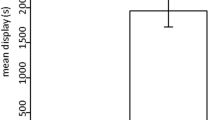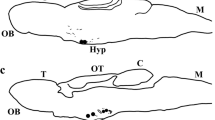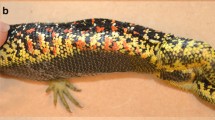Abstract
In many haplochromine cichlids, body coloration is an important communication cue during social interactions. In some cichlids, individuals can change color, but we have little information about the underlying physiological mechanisms. We examined the regulation of coloration in the color polymorphic cichlid fish Astatotilapia burtoni where males are either blue or yellow. Previous studies implicated the melanocortin system, a neuroendocrine center that regulates pigmentation and the stress response, in regulating the color polymorphism in this species. We found that both blue and yellow males express a high density of yellow xanthophores. Dispersal of xanthophore pigments in both yellow and blue morphs occurred within minutes in a dose-dependent manner. Similarly, exogenous α-melanocyte stimulating hormone (α-MSH, a melanocortin hormone) increased yellowness of the body in a dose-independent fashion. We observed many color changes in males housed in social communities with the proportion of yellow males increasing over the 2-week experimental period. However, color phenotype or color change was not influenced by experimental alteration of the stability of the social hierarchy. The effects of α-MSH suggest that the melanocortin system contributes to the polymorphism in coloration in A. burtoni but the role of social interactions and social stress in regulating color remains unclear.







Similar content being viewed by others
References
Cerdá-Reverter, J. M., M. J. Agulleiro, R. Guillot, E. Sánchez, R. Ceinos & J. Rotllant, 2011. Fish melanocortin system. European Journal of Pharmacology 660: 53–60.
Cone, R. D., 2006. Studies on the physiological functions of the melanocortin system. Endocrine Reviews 27: 736–749.
Cortesi, F., Z. Musilová, S. M. Stieb, N. S. Hart, U. E. Siebeck, K. L. Cheney, W. Salzburger & N. J. Marshall, 2016. From crypsis to mimicry: changes in colour and the configuration of the visual system during ontogenetic habitat transitions in a coral reef fish. The Journal of Experimental Biology 219: 2545–2558.
Dijkstra, P. D. & S. E. Border, 2018. How does male-male competition generate negative frequency-dependent selection and disruptive selection during speciation? Current Zoology 64: 89–99.
Dijkstra, P. D. & T. G. G. Groothuis, 2011. Male-male competition as a force in evolutionary diversification: evidence in haplochromine cichlid fish. International Journal of Evolutionary Biology 2011: 1–9.
Dijkstra, P. D., O. Seehausen, B. L. A. Gricar, M. E. Maan & T. G. G. Groothuis, 2006. Can male-male competition stabilize speciation? A test in Lake Victoria haplochromine cichlid fish. Behavioral Ecology and Sociobiology 59: 704–713.
Dijkstra, P. D., R. Hekman, R. W. Schulz & T. G. G. Groothuis, 2007. Social stimulation, nuptial colouration, androgens and immunocompetence in a sexual dimorphic cichlid fish. Behavioral Ecology and Sociobiology 61: 599–609.
Dijkstra, P. D., G. F. Wiegertjes, M. Forlenza, I. van der Sluijs, H. A. Hofmann, N. B. Metcalfe & T. G. G. Groothuis, 2011. The role of physiology in the divergence of two incipient cichlid species. Journal of Evolutionary Biology 24: 2639–2652.
Dijkstra, P. D., S. M. Maguire, R. M. Harris, A. A. Rodriguez, R. S. DeAngelis, S. A. Flores & H. A. Hofmann, 2017. The melanocortin system regulates body pigmentation and social behaviour in a colour polymorphic cichlid fish. Proceedings of the Royal Society B: Biological Sciences 284: 20162838.
Ding, B., D. W. Daugherty, M. Husemann, M. Chen, A. E. Howe & P. D. Danley, 2014. Quantitative genetic analyses of male color pattern and female mate choice in a pair of cichlid fishes of Lake Malawi, East Africa. PLoS ONE 9: e114798
Ducrest, A. L., L. Keller & A. Roulin, 2008. Pleiotropy in the melanocortin system, coloration and behavioural syndromes. Trends in Ecology and Evolution 23: 502–510.
Fernald, R. D., 1977. Quantitative behavioural observations of Haplochromis burtoni under semi-natural conditions. Animal Behaviour 25: 643–653.
Fernald, R. D. & K. P. Maruska, 2012. Social information changes the brain. Proceedings of the National Academy of Sciences 109: 17194–17199.
Henning, F., J. C. Jones, P. Franchini & A. Meyer, 2013. Transcriptomics of morphological color change in polychromatic Midas cichlids. BMC Genomics 14: 171.
Grether, G. F., N. Losin, C. N. Anderson & K. Okamoto, 2009. The role of interspecific interference competition in character displacement and the evolution of competitor recognition. Biological Reviews 84: 617–635.
Harris, R. M., P. D. Dijkstra & H. A. Hofmann, 2014. Complex structural and regulatory evolution of the pro-opiomelanocortin gene family. General and Comparative Endocrinology 195: 107–115.
Hofmann, H. A., M. E. Benson & R. D. Fernald, 1999. Social status regulates growth rate: consequences for life-history strategies. Proceedings of the National Academy of Sciences 96: 14171–14176.
Hogben, L., D. Slome, 1931. The Pigmentary Effector System. VI. The Dual Character of Endocrine Co-Ordination in Amphibian Colour Change. Proceedings of the Royal Society B: Biological Sciences 108: 10–53.
Kang, C., Y. E. Kim & Y. Jang, 2016. Colour and pattern change against visually heterogeneous backgrounds in the tree frog Hyla japonica. Scientific Reports 6: 22601.
Kobayashi, Y., K. Mizusawa, Y. Saito & A. Takahashi, 2012. Melanocortin systems on pigment dispersion in fish chromatophores. Frontiers in Endocrinology 3: 9.
Korzan, W. J. & R. D. Fernald, 2007. Territorial male color predicts agonistic behavior of conspecifics in a color polymorphic species. Behavioral Ecology 18: 318–323.
Korzan, W. J., R. R. Robison, S. Zhao & R. D. Fernald, 2008. Color change as a potential behavioral strategy. Hormones and Behavior 54: 463–470.
Leclercq, E., J. F. Taylor & H. Migaud, 2010. Morphological skin colour changes in teleosts. Fish and Fisheries 11: 159–193.
Ligon, R. A. & K. L. Mccartney, 2016. Biochemical regulation of pigment motility in vertebrate chromatophores: a review of physiological color change mechanisms. Current Zoology 62: 237–252.
Maan, M. E. & K. M. Sefc, 2013. Colour variation in cichlid fish: developmental mechanisms, selective pressures and evolutionary consequences. Seminars in Cell and Developmental Biology 24: 516–528.
Maan, M. E., M. P. Haesler, O. Seehausen & J. J. M. Van Alphen, 2006. Heritability and heterochrony of polychromatism in a Lake Victoria cichlid fish: stepping stones for speciation? Journal of Experimental Zoology Part B: Molecular and Developmental Evolution 306: 168–176.
Malinsky, M., R. J. Challis, A. M. Tyers, S. Schiffels, Y. Terai, B. P. Ngatunga, E. A. Miska, R. Durbin, M. J. Genner & G. F. Turner, 2015. Genomic islands of speciation separate cichlid ecomorphs in an East African crater lake. Science 350: 1493–1498.
Maruska, K. P. & R. D. Fernald, 2010. Behavioral and physiological plasticity: rapid changes during social ascent in an African cichlid fish. Hormones and Behavior 58: 230–240.
Maruska, K. P., L. Becker, A. Neboori & R. D. Fernald, 2013. Social descent with territory loss causes rapid behavioral, endocrine and transcriptional changes in the brain. Journal of Experimental Biology 216: 3656–3666.
Meier, J. I., D. A. Marques, S. Mwaiko, C. E. Wagner, L. Excoffier & O. Seehausen, 2017. Ancient hybridization fuels rapid cichlid fish adaptive radiations. Nature Communications 8: 14363.
O’Connell, L. A. & H. A. Hofmann, 2012. Social status predicts how sex steroid receptors regulate complex behavior across levels of biological organization. Endocrinology 153: 1341–1351.
Pauers, M. J., T. J. Ehlinger & J. S. McKinnon, 2010. Female and male visually based mate preferences are consistent with reproductive isolation between populations of the Lake Malawi endemic Labeotropheus fuelleborni. Current Zoology 56: 65–72.
R Core Team, 2012. R: A language and environment for statistical computing. R Foundation for Statistical Computing, Vienna, Austria.
Salzburger, W., 2009. The interaction of sexually and naturally selected traits in the adaptive radiations of cichlid fishes. Molecular Ecology 18: 169–185.
Seehausen, O. & D. Schluter, 2004. Male-male competition and nuptial-colour displacement as a diversifying force in Lake Victoria cichlid fishes. Proceedings of the Royal Society B: Biological Sciences 271: 1345–1353.
Seehausen, O. & J. J. M. Van Alphen, 1998. The effect of male coloration on female mate choice in closely related Lake Victoria cichlids (Haplochromis nyererei complex). Behavioral Ecology and Sociobiology 42: 1–8.
Seehausen, O., Y. Terai, I. S. Magalhaes, K. L. Carleton, H. D. J. Mrosso, R. Miyagi, I. Van Der Sluijs, M. V. Schneider, M. E. Maan, H. Tachida, H. Imai & N. Okada, 2008. Speciation through sensory drive in cichlid fish. Nature 455: 620–626.
Selz O. M., M. E. R. Pierotti, M. E. Maan, C. Schmid & O. Seehausen, 2014. Female preference for male color is necessary and sufficient for assortative mating in 2 cichlid sister species. Behavioral Ecology 25: 612–626
Sköld, H. N., T. Amundsen, P. A. Svensson, I. Mayer, J. Bjelvenmark & E. Forsgren, 2008. Hormonal regulation of female nuptial coloration in a fish. Hormones and Behavior 54: 549–556.
Sköld, H. N., S. Aspengren & M. Wallin, 2013. Rapid color change in fish and amphibians – function, regulation, and emerging applications. Pigment Cell and Melanoma Research 26: 29–38.
Tinghitella, R. M., A. C. R. Lackey, M. Martin, P. D. Dijkstra, J. P. Drury, R. Heathcote, J. Keagy, E. S. C. Scordato & A. M. Tyers, 2018. On the role of male competition in speciation: a review and research agenda. Behavioral Ecology 29: 783–797.
Vokey, J. E. & D. Burton, 1998. Sensitivity of winter flounder melanophores after removal of the epidermis from in vitro preparations. Journal of Fish Biology 53: 695–700.
Weissing, F. J., P. Edelaar & G. S. van Doorn, 2011. Adaptive speciation theory: a conceptual review. Behavioral Ecology and Sociobiology 65: 461–480.
Acknowledgements
We thank members of the Dijkstra lab for providing helpful comments to earlier drafts of the manuscript.
Author information
Authors and Affiliations
Corresponding author
Additional information
Guest editors: S. Koblmüller, R. C. Albertson, M. J. Genner, K. M. Sefc & T. Takahashi / Advances in Cichlid Research III: Behavior, Ecology and Evolutionary Biology
Rights and permissions
About this article
Cite this article
Border, S.E., Piefke, T.J., Fialkowski, R.J. et al. Color change and pigmentation in a color polymorphic cichlid fish. Hydrobiologia 832, 175–191 (2019). https://doi.org/10.1007/s10750-018-3755-0
Received:
Revised:
Accepted:
Published:
Issue Date:
DOI: https://doi.org/10.1007/s10750-018-3755-0




